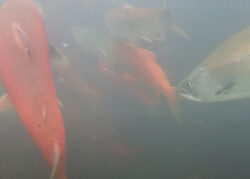by Nicole Doran, Dave Lamb Memorial scholarship winner, and third year Master’s student at the University of Washington School of Aquatic and Fishery Sciences
 Not all salmon go to the ocean. Kokanee salmon (Oncorhynchus nerka) are a freshwater ecotype of sockeye salmon that have evolved to spend their entire lives in lakes. One such lake is Lake Sammamish, located in western Washington just twenty miles east of Seattle. Kokanee, also known locally as the “little red fish”, is an incredibly important species for the local communities of Sammamish. They were a traditional food and culturally important animal to the Snoqualmie Tribe. Lake Sammamish Kokanee are also genetically distinct from other Kokanee populations in the Pacific Northwest and British Columbia. You can read more about the Snoqualmie Tribe’s connection to Lake Sammamish and Kokanee here! They were once a popular sportfish in Lake Sammamish for recreational anglers as well. However, drastic population declines over the past few decades have affected both recreational fishers and the Snoqualmie Tribe’s relationship to the little red fish.
Not all salmon go to the ocean. Kokanee salmon (Oncorhynchus nerka) are a freshwater ecotype of sockeye salmon that have evolved to spend their entire lives in lakes. One such lake is Lake Sammamish, located in western Washington just twenty miles east of Seattle. Kokanee, also known locally as the “little red fish”, is an incredibly important species for the local communities of Sammamish. They were a traditional food and culturally important animal to the Snoqualmie Tribe. Lake Sammamish Kokanee are also genetically distinct from other Kokanee populations in the Pacific Northwest and British Columbia. You can read more about the Snoqualmie Tribe’s connection to Lake Sammamish and Kokanee here! They were once a popular sportfish in Lake Sammamish for recreational anglers as well. However, drastic population declines over the past few decades have affected both recreational fishers and the Snoqualmie Tribe’s relationship to the little red fish.

Figure 1. As water temperatures warm throughout the summer months, Kokanee salmon are constricted to narrower ranges of the water column as surface temperatures warm, and the depths become hypoxic.
Like most salmonids, Kokanee in Lake Sammamish are exposed to many stressors such as habitat degradation and increasing water temperatures due to climate change. Their land-locked nature exposes them to even greater anthropogenic and environmental stressors than their anadromous counterparts, which likely contributed to their population decline. For example, Lake Sammamish undergoes a phenomenon called the temperature-dissolved oxygen squeeze that limits Kokanee range within Lake Sammamish (Figure 1).
Other potential stressors for Kokanee are predation by non-native species or competition for resources. Kokanee and non-native species such as yellow perch, largemouth bass, and smallmouth bass, have co-existed in Lake Sammamish for decades, but climate change could cause a shift in species assemblage that favors the non-native species better adapted for warm water temperatures over salmonids such as Kokanee that prefer cold water. This shift could exacerbate any influences of predation or competition on the threatened Kokanee population. However, it is not currently known which species are preying on Kokanee in Lake Sammamish and to what degree.
I am collaborating with the Kokanee Work Group of Lake Sammamish to address this pressing ecological question. Last spring, I worked with the US Fish and Wildlife Service to collect non-native fish for stable isotope analysis. Stable isotope analysis looks at the ratios of C13 and N15 present in fish muscle tissue; these ratios can provide insight into food web interactions occurring between species. This approach will allow me to quantify the effects of predation and competition by species on Kokanee salmon. The stable isotope analysis component of this project will be made possible by funding from WALPA’s Dave Lamb Memorial Scholarship.
Results of this experiment will directly inform management actions taken by the Kokanee Work Group to conserve the “little red fish”. Quantifying inter-specific interactions between Kokanee and non-native species in Lake Sammamish will identify management priorities to give Kokanee the best chance for recovery in Lake Sammamish. For more information on the Kokanee Work Group’s conservation efforts, check out their website.









